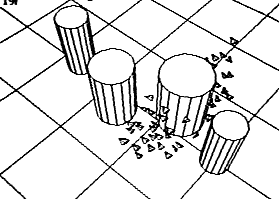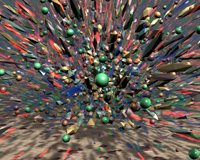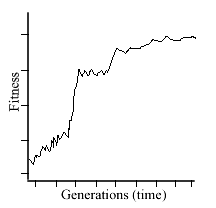7th Conference
on Artificial Life and Robotics, Beppu, Oita, Kyushu, Japan, January 2002
| |
The
Visual Aspect
of Artificial Life
|
|
Alan
Dorin
http://www.cs.monash.edu.au/~aland
aland@cs.monash.edu.au |
| |
Centre
for Electronic Media Art (CEMA)
School of Computer Science & Software Engineering
Monash University, Melbourne, Australia |
| |
Special
thanks
Rodney Berry & Ryohei Nakatsu, ATR, Kyoto, Japan
Christa Sommerer & Laurent Mignonneau, IAMAS, Gifu, Japan
Mark Bedau, Reed College, Portland, USA
Masanori Sugisaka, Oita University, Oita, Japan |
- Humans depend to a very large degree on sight to identify and classify objects
and their relationships.
- The visible world is constructed by the physiology of the eye, the
optical nerve and the brain.
- Much of what follows may seem obvious to you. (Sugoi!) The purpose of this
paper is to ask you to consider deeply the relationship between computer visualizations
of a-life and the information which is conveyed using imagery.
-
Seeing emergent phenomena
-
Seeing spatial relationships
-
Seeing state-based relationships
|
|
After Polanyi (1968)...
Emergence/supervenience is the appearance of properties or behaviours of
a set of components which may in principle be unpredictable by reference only
to the rules governing their individual interactions, but which nevertheless
arise through these same rules.
For example...
Reynolds' boids...
- The virtual flock (or school) emerges
- The movement / flocking or schooling "behaviour" emerges
Conway's The Game of Life and its glider...
- The glider's (dynamic) "topology" emerges
- The "movement" of the glider (tied inseparably to its topology
in this case) emerges
| |
Seeing
emergent phenomena |
Tufte (an information visualization expert) writes...
"Comparisons must be enforced within the
scope of the eyespan"
- Is it possible that emergent phenomena will only be recognized if
very particular visualization methods are utilized in specific cases?
- What are the features that need to be experienced "within the scope
of the eyespan" for us to see a flock of boids or a mobile glider?
- How might an understanding of these issues assist us to engineer/observe
further examples of emergent phenomena?
| |
Seeing
spatial relationships (flocks) |
- A recognizable feature of a flock (or school) is the spatial proximity
of its members at any moment in time.
- Creatures are spread through a volume which encompasses "the flock".

Is this a flock?
The usual visualization strategy for a computer-based "flock" is
to compute boid locations in 3D Cartesian space, perspective project these
co-ordinates into a 2D plane, and display the result on a flat screen.
Alternatives:
-
Preserve 3D location and map this into 2 dimensions by
perspective projection (as above) but provide a variable viewpoint
- Preserve 3D location and visualize in 3 dimensions
Employ stereoscopy or holography for example
- Tabulate or list all boid Cartesian co-ordinates!
E.g. (1.0001, -2.534, 3.3356), (2.5654, -3.2111, 4.3254),
(8.5129, -5.6778, 3.9533)...
- Write a description describing the shape and volume of the flock.
E.g. The flock is almost spherical although it has a bulbous
protrusion from one end where the density increases. There is one stray
creature a little off to the left back from the other members of the flock.
A small group of creatures is breaking away from the bottom into a tear-drop
shaped sub-flock. The birds in this tear-drop (there are about seven of
them) are less closely packed than...
Obviously, the usual method is not the best way to convey the volume of a
flock!
But there are less effective methods.
| |
Seeing
spatial relationships (gliders) |
Recognizable features of a glider:
- One of four possible configurations / patterns of active cells at any
time (& mirrored versions)
- The pattern's isolation from other active cells
- The glider is constructed in (virtual) 2D space.
- The neighbourhood relations between cells in the 2D visualization represent
neighbourhood relations between automata in the (virtual) connected network.
- If the visualization neighbourhood relations are randomized, but the virtual
network neighbourhood relations are preserved (something which can't be done
with physical/chemical systems), whilst there is still (logically) a "glider",
it may not be perceived.
Alternatives:
- Any technique for representing/encoding a one-bit per-pixel image may
be used.
E.g. List active cells indexed from 0 at the top left of
the grid: 1,5,6,7,8
- Describe the shape of the glider.
E.g. The glider is pentagonal and looks like a child's drawing
of a house, except that the left wall is missing. It looks a bit like a
fish hook lying on its side.
| |
Seeing
spatial relationships (additional factors) |
"Panorama, vista and prospect deliver to
viewers the freedom of choice that derives from an overview, a capacity to compare
and sort through detail." - Tufte
Turing machine implemented in the Game of Life.
Taken from an image by Paul Rendell,
April 2000
| |
Seeing
state-based relationships (flocks) |
Frequently visualized state information includes:
- Direction of travel of individual members
May be indicated by 'head/tail' or 'front' feature (e.g.a
triangular body form)

Craig Reynolds'
boids, 1987
- Speed of travel of individual members
May use 'tail' length, motion blur etc.

Karl
Sims' Panspermia, 1990
| |
Seeing
state-based relationships (gliders) |
Frequently visualized state information includes:
- The current state (active/inactive) of a cell
Active cells are usually coloured differently to inactive
cells
(Or inactive cells aren't "coloured" at all, these cells being considered
quiescent / background)
- History of state transitions for a cell
Recently de-activated cells may be coloured in a colour different
to long-term inactive cells
| |
Seeing
temporal relationships |
In (virtual) biology, essential elements are processes, rather than
static entities and relations
The time-series plot is a frequently employed device for displaying
change. For example...

The ubiquitous "Fitness vs. Time"
graph
| |
Seeing
temporal relationships (flocks & gliders) |
Temporal relationships needing display include all boid and glider characteristics
discussed above, including:
- Spatial relationships
- State-based relationships
A visualization tool called "small multiples" may be utilized with
some degree of success...

Muybridge's "Animal Movement" photographs are also an
example of what may be learnt using this technique.
- But, how do these visualization techniques compare with the power of animation
for understandingthe "movement" of these patterns?
- Do "small multiples" convey the emergentproperties of the
flock or glider?
Lack of attention to visualization principles will result in a lack of understanding.
But just as dangerously, visualization techniques give apparent "life"
and substance to inanimate, abstract patterns.
Consider carefully what aspects of an abstract system need to be visualized
and the best way to do this.
Ki o tsukete!
©Copyright Alan
Dorin/Animaland 2002



















